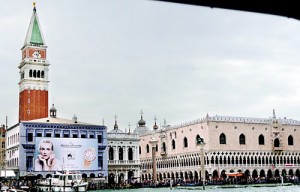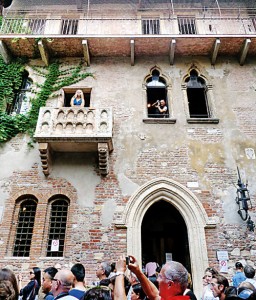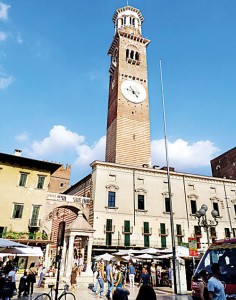From a city of canals to a city of opera and Juliet
The city of Venice came into being in 421 AD when Roman settlers fled to a small group of islands in the north of the country from the invading

Venice: The Doges Palace seen from the Grand Canal
Barbarians. Venice is known as the “City of Lovers and Canals”. The Grand Canal is the main thoroughfare and cuts through the northern and southern part of the city.
There are over 300 bridges which link the 118 islands and vehicles are not allowed into the city. Vaporettos (water taxis and buses) are the main means of transportation. Gondolas can utilize the smaller canals and are a great tourist attraction. They are expensive though and hiring a singer to steer you would be an added charge.
We caught a water taxi from Marco Polo airport and raced across the water channel to our abode in San Stai. The spires and cupolas of the churches, the water birds and the imposing buildings were our first sight of this romantic city.
St. Mark is the patron saint of the city and the symbol of the city the “winged lion” is depicted on many old buildings with the motto “Peace be to you St Mark the Evangelist”. St. Mark (one of the Apostles of Christ) died in Alexandria, Egypt and his body was smuggled in a wicker basket with pork fat by his disciples to the city thus evading the Ottomans. His body lies in St. Mark’s Cathedral in the square named after him, which is a hive of activity. His tomb is encrusted with 2,500 precious stones. The five cupolas and four bronze horses are a feature of the church.

the colourful houses of Burano
Not to be missed is the Gothic-styled white and pink stone Doges Palace or Palaccio Ducale in St. Mark’s Square begun in the 9th century and overlooking the Grand Canal. A council of ten ruled the city and a Doge (Leader) was chosen as the head of the council from a chamber of 40 leading families of the city. If the Doge erred in any way during his rule, his property was confiscated by the State and his nearest of kin penalised. The private apartments, offices, council chambers and prisons are all housed in this building.
Prisoners were taken by boat under the Bridge of Sighs which linked the palace and the prison knowing they would never return. The Door of Bills was designed by Antonio Rizzo in 1500 and was known as the Giants’ Staircase with the huge statues of Mars and Neptune flanking the entrance. The golden staircase by which one enters the apartments is ornately decorated with gold work and frescoes. Each room is finely decorated and

Verona: The Juliet House
Tintoretto’s huge canvas of “Paradise” leaves the visitor humbled. The palace was utilized for 700 years during the time of the Venetian Republic and finally fell to Napoleon. It was Napoleon who famously called St Mark’s Square in Venice “the Drawing Room of Europe”.
A ride down the Grand Canal is a must and a number of the palaces have now been turned into hotels and restaurants. Eating near the tourist sites is not recommended as the food is expensive and not worth the price. We discovered a wonderful small restaurant “La Zucca” which was originally vegetarian but has now expanded its menu. The restaurant was always reserved and the vegetarian lasagna that I had there was the best. Fish encrusted with salt, squid in black ink are other Venetian delicacies that we savoured and the famous desert, Tiramisu.
The Rialto Bridge is another famous Venetian icon spanning the Grand Canal and considered one of the oldest bridges. The bridge is surrounded by a host of shops and the market close by teems with tourists. The bridge was originally made of wood and the shops located on it assisted the

Verona Square
Treasury to maintain the bridge. In the 15th century it was rebuilt in white stone and has withstood the test of time despite the remarks of an architect that it would not survive.
There are numerous churches and artworks to be seen and the traveller has to make an informed choice. I visited St Mary’s Friary Church to see the “Assumption” and Titian’s burial place. I sat in the San Rocco church which houses a number of Tintoretto’s works and listened to a choir preparing for the evening concert.
Our final stop for the day was the Academia, which houses the works of artists such as Bellini, Tintoretto, Robusti and paintings such as the “Raising of Lazarus”, “Madonna and Child” and “John the Baptist” by Del Moro.
On the way back I walked to the other part of the city over one of the numerous bridges to look at the Cadero or famous Gold House now without its lustre. Venice leaves the tourist enthralled with the magic of its presence.
Murano
We took a trip by vaporetto to the island of Murano where the famous Venetian glass factories are located. On payment of a small fee we could see how the glass is crafted in the furnace and to our astonishment we found one of the assistants of the master was a Sri Lankan, Suranga who had been working there for ten years. Happily settled in Italy with his family, he said he would not return to his country.
Burano
This cluster of four islands with a population of just 2,800 is also situated in the Venetian lagoon. It takes 40 minutes to get to the islands and a major attraction here is the brightly painted rows of homes. The owners are not allowed to have their choice of colour for the exterior but do so in conjunction with the Government. Burano’s women lace makers are not to be missed.
Verona: The city of opera and Romeo and Juliet
A train ride from Santa Lucia station in Venice which was a couple of hours took us to Verona, a world heritage site with a population of 265,000 and with the highest per capita income in Italy. Our hotel, “Accademia” was centrally situated and we explored the city by taking the Hop on and off bus from the Piazza Bra.
We were driven to the vantage points to see views of Verona, the river Adige with the many bridges that flanked it; the spires of the churches and the cluster of ancient amidst the newer buildings. Verona had a lot of Roman influence and Julius Caesar used to relax in the city.
The Juliet house is where throngs of people gather to pay homage to the 16th century lovers immortalised by Shakespeare based on a true story of two feuding families (one of which were the Capellos). The entrance arch is full of letters stuck to it – some 5,000 letters arrive annually from all over the world over addressed to Juliet and are answered by a committee. A statue of Juliet stands in the foreground and the legend states that if one touched her left breast one’s wish will be granted. The house is now a museum and the reputed balcony is, in fact, a new addition. The tomb of Juliet as stated in the guide books is a myth and not worth visiting.
Seeing the opera “Aida” staged at the Arena di Verona, the Roman amphitheatre was indeed a magical experience, seated amidst nearly 25,000 people from all parts of Europe. The performance began at 9 p.m. and went on till nearly 12.45 a.m. and the costumes, singing and performance were excellent. Four white horses were brought on stage in one of the acts.
On a hot summer afternoon we took a train to Desenazanodel and then a bus ride through lovely small leafy villages and finally to the large expanse of Lake Garda, the third largest lake in Italy and to the picturesque and popular village of Sirmione with its castle.
Next week: Florence


